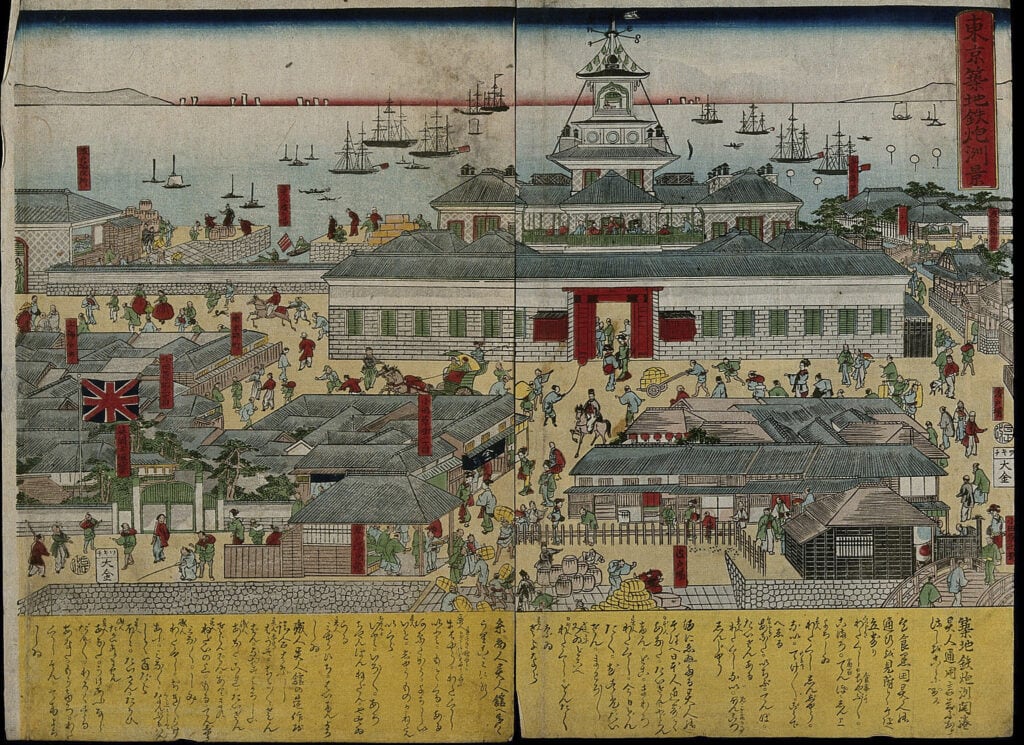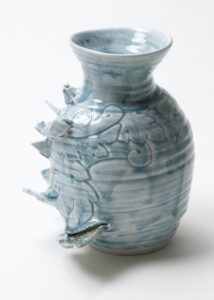Nigiri are the typical Japanese sushi appetizers that consist of a pressed, roughly rectangular piece of rice with a topping placed on top.
This topping (neta or sushidane) can consist of raw, marinated, flamed fish, raw or cooked seafood, egg or other ingredients. Characteristic is the elongated shape of the rice morsel, on which the topping is slightly overlapping.
Nigiri is served warm to the touch so that the rice and toppings fall delicately on the tongue and can develop their full flavor.
Nigiri are often considered the "classic" form of sushi - at least, they are the form that is most common in good Japanese sushi bars and most typical of Japan.
Typical ingredients or toppings for nigirizushi are various types of fish (maguro, toro, shake, hamachi, tai, etc.), but nigiri can also be topped with vegetarian ingredients such as avocado, egg drop or wagyu (meat).
Name "Nigri" derives from the preparation technique
The word 握り (nigiri) comes from the Japanese verb "to grasp", 握る (nigiru).
And this already indicates how nigiri sushi is formed: You grab with your hand the appropriate amount of sushi rice, usually between 15 and 20 grams. This rice is pressed into an oval shape in one hand only. With the other hand, the topping is placed. Then the fingers are closed slightly over the rice with topping, so that the two can combine. It is important not to apply too much pressure. Nigiri sushi must hold together just enough for the morsel to rest on the tongue. Then it is allowed to fall apart.
Although the appearance is so simple, nigiri sushi requires a high degree of skill. Especially important is the proper handling of the rice, from the washing process to the cooking of the rice and shaping of the nigiri: when the piece is picked up with chopsticks or fingers, the rice must not fall apart. But in the mouth, the oval piece of rice must immediately unfold into its small parts to develop the best taste experience together with the topping.
By the way, some sushi restaurants, including those in Munich, make use of sushi robots, small automatic machines that produce appropriately pressed rice shapes so that they simply have to be topped with fish. But this does not really lead to good sushi.
Nigiri was the street food of the Edo period
Nigiri sushi became popular about 200 years ago. In Edo, today's Tokyo, this then still new form of sushi originated. So nigiri sushi is much younger than other forms of sushi. And today it is the most famous form of sushi among Japanese people.
It is nigiri sushi simply an oval piece of sushi rice topped with a thinly sliced piece of raw fish, shellfish, cooked eel or omelet. These ingredients are referred to as 寿司種 (sushidane) or as ネタ (neta).
Nigiri sushi was sold in the Edo period (1603-1868) primarily as street food in small huts on the street. The small rice bites became really popular through merchants who had found their fortune in Edo, as well as through the well-heeled inhabitants of the city. It was said of the people of Edo that they had no money to spend at night, because everything they earned during the day they spent the same day. Sushi quickly went from street food to a restaurant format, and a high-class one at that (cf. https://www.eonet.ne.jp/~shoyu/mametisiki/reference-3.html).
How to eat nigiri sushi?
Nigiri sushi can be eaten with chopsticks as well as with fingers.
Chopsticks are a bit of a challenge: it gets easier when the nigiri sushi is placed on its side.
The correct way is not to dip the rice into the soy sauce, but the neta side, i.e. the topping. The reason is simple: if the rice comes into contact with the soy sauce, it disintegrates more quickly. Also, the rice naturally absorbs much more soy sauce than the topping, which makes the sushi taste too salty - soy sauce should always be only a light accent in sushi.
Ideally, the sushi piece should then land on the tongue with the topping facing down, as this allows the flavor to develop even better.
Nigiri sushi individually or as a pair?
A bit of trivia: why do many restaurants always offer nigiri in pairs of two?
Insight into the history of Nigiri & SUSHIYA
This actually has historical reasons from the development of sushi as street food of the Edo period, when the method of preserving raw fish became a quick snack for the emerging society of Edo, now Tōkyō.
Why nigiri are often offered in pairs
Sushi masters think it's easier to eat two small nigiri sushi than one big one. At least, that's the popular opinion. And, of course, it's always better to have two appetizers in front of you instead of just one - it's also in keeping with a sense of symmetry rooted in Japanese of old that two uniform things are nicer than a single, larger one.
In fact, however, there is no set rule or tradition that would determine whether nigiri sushi is served individually or in pairs (cf.
http://www.ja-gp-fukuoka.jp/education/akiba-hakase/001/005.html).
From compact meals to smaller bites
According to legend, it wasn't until the end of the Edo period that nigiri sushi could be comfortably eaten in one bite. Before that, the sushi pieces were about three times the size of today's nigiri sushi.
Nigiri sushi as we know it today probably dates back to a sushi master in Ryogkoku (district in present-day Tōkyō) named Hanaya Yohei, who divided nigiri into two pieces.
He did this so that the parts would be easier to eat. And he always served the two separate parts together on one plate, in keeping with the Japanese sense of symmetry.
Aesthetic basic feeling and bite size
After all, for Japanese today, it is also very unseemly to bite off a nigiri or a sushi and put it back on the plate or even try to crush it with a knife and fork or chopsticks.
The Japanese demand for perfection leads the chef to prepare the food so that it can be eaten by the guest with ease and elegance. Ultimately, these are the thoughts reflected in the Japanese art of serving, Moritsuke. (Link to Moritsuke)
It's also about a certain perceived aesthetic - eating with a knife and fork, where what's on the plate is cut up like a big roast pork and then put in the mouth in uneven pieces, is a different matter in terms of appearance, too.
Why a knife has no place at the Japanese dining table
Not only for aesthetic reasons, but also as an expression of civility, one can explain the pursuit of bite-size in Japanese cuisine.
A knife, one could say from a Japanese point of view, belongs on the battlefield or in the kitchen, but not on the table if one wants to enjoy the cuisine of harmony. This is not only explained by the Japanese earlier feudalistic society, where very careful attention was paid to when swords and weapons could be carried where at what Gelegeheut.
It is also explained by the existential link of Japanese society with rice and Shintoism. In the Edo period (1603-1867), when sushi as we know it today originated, rice was more valuable than anything else and was also used to pay annual taxes. As is well known, rice is not only used to make sake - the drink of the gods. Rice was also used to make small balls to sacrifice to the gods. To break and share such a ball would instinctively be perceived by a Japanese as disrespect for the gods.
Why in the restaurant sansaro small texts are hidden in the chopstick wrappers
By the way, at this point a little excursion behind the scenes of our restaurant:
if you instinctively understand and carry this sense of Japanese harmony and aesthetics, then you can also understand why we have been hiding (with much effort) small, different tete in our chopstick casings for many years and have given it much thought.
Because in the early years there were sometimes guests in our restaurant who, lost in thought and certainly without any ill will, started tearing, tattering, doing all sorts of things with the chopstick wrappers in our restaurant while waiting.
When you see this with Japanese-sensitive eyes, you involuntarily flinch and feel a slight shock.
Our idea, on the other hand, was to hide lots of little texts inside the chopstick wrappers, texts about Japanese culture. As an antidote to customers simply tearing our wrappers made for them.
And it worked, because we don't see customers doing that anymore. When they unfold the covers, lost in thought, they now find all kinds of little texts about Japanese culture, hidden tidbits. There's no money in it, but there's still a lot of effort and attention to detail - a wonderful symbol of our commitment at SUSHIYA to Japanese cuisine and culture.
But rest assured: of course you may still fold the chopstick wrappers to use as small chopstick banks (hashi oke) for hygienic placement of the chopsticks. The intention here is quite different and deliberate.
From the excursion to the harmony of the Japanese soul, where you don't want to tear things apart and thus prefer to make two small ones rather than one (too) big one, back to the question of whether nigiri should be served as singles today or always in pairs.
Choose individually or enjoy classically as a pair
Today, while it is out of this tradition that many "classic" Japanese restaurants always serve nigiri as a pair of two.
Modern restaurants in the West or highly specialized omakase restaurants in Japan often offer the nigiri and gunkan individually. The reason for this is quite simple: two nigiri naturally cost more than one.
And some restaurants simply want to let diners decide for themselves which nigiri they want to try just one of, or order two at once.
In the restaurant sansaro you have the choice of
With this in mind, for example, our first chef, sushi master Yuri Yagawa, stipulated when we opened our restaurant sansaro that you should be able to order the nigiri individually - also because otherwise the German guest would automatically ask why he always had to order two pieces and whether he couldn't order them individually.
So take the opportunity with us to try the most diverse nigiri and treat yourself to ordering two of those that experience has shown you taste best: This is not a sign of excess, but almost Japanese tradition.
Because two delicious things are of course better than one 😉







